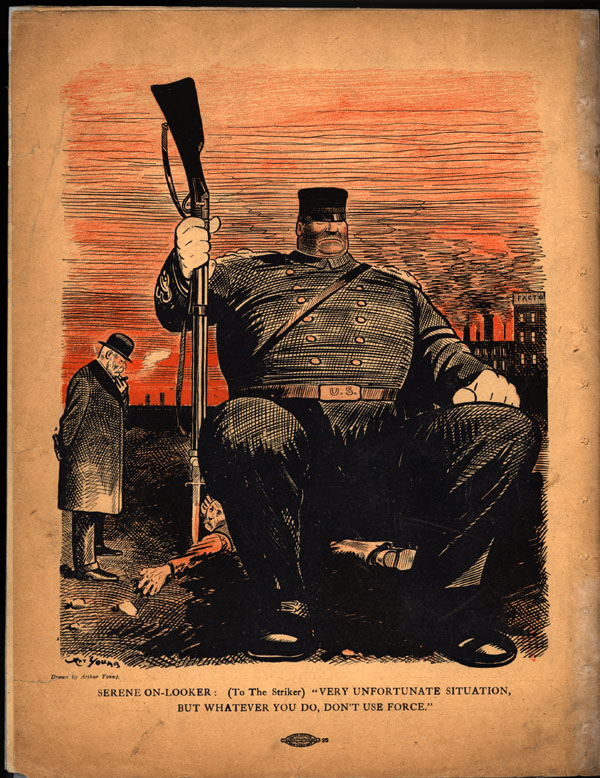An iconographic and text archive related to communication, technology and art.
☛ The Special Collections unit of the Michigan State University Libraries: The Masses, back cover art by Arthur Young, February 191 (most likely Public Domain).
Arthur “Art” Young (1866-1943) was an American illustrator famous for his satirical cartoons and his contribution to the socialist magazine The Masses:
In March 1902 Young was commissioned to draw an anti-immigration picture for Life. After it was published he sent back the $100 cheque and vowed that in future he would only draw pictures that reflected his own political beliefs. By this time Young’s work was so highly valued that newspapers and magazines were willing to accept his drawings attacking inequality and supporting causes he believed in such as women’s rights.
When Piet Vlag decided to start a new socialist magazine, The Masses, in 1910, he asked Young to join him. Other early members of the team included Louis Untermeyer and John Sloan. Organised like a co-operative, artists and writers who contributed to the journal shared in its management. According to Barbara Gelb: “After about a year and a half the Masses floundered and its tiny staff of contributors, which included the artist, John Sloan, the cartoonist, Art Young, and the poet, Louis Untermeyer, held an emergency session to rescue it. It was Young’s idea to ask Max Eastman, a twenty-nine-year-old Columbia professor who had recently been dismissed for his radical views, to take over the editorship of The Masses.” (Spartacus Educational: Art Young Biography)
According to the Michigan State University Libraries Special Collections website, The Masses represents the birth of a special bound between art and politics in 20th century America (think Shepard Fairey’s “Obama”):
With the appearance in America of The Masses in 1911, a new alliance was formed between art and politics. Originally established as an earnest but ultimately dull socialist magazine, The Masses was taken over in 1912 by artists whose commitment to a new artistic age was only equalled by their support of socialist political causes. Modeled after the lavishly illustrated European satiric journals, Simplicissimus and L’Assiette au Beurre, the artists hired Max Eastman as editor who moved the magazine away from socialist “dogma” toward a more far-ranging program condemning racism, supporting women’s rights, and promoting the work of a galaxy of writers and thinkers, including John Dewey, Carl Sandburg, Amy Lowell, John Reed, and Sherwood Anderson.
The Masses was particularly noted for its art. As official art editor, John Sloan designed the layout and worked with printers to reproduce vivid two color covers and heavy black crayon drawings. The magazine attracted a number of urban realists who later became known as the Ashcan School (George Bellows, Stuart Davis, Glen Coleman and others); their drawings sought to offer raw appearing glimpses of the lower classes in daily life and in moments of crisis. Unlike nineteenth century American prints which typed the poor as coarse or pathetic, these images were drawn from life. Rather than neat and finished, the style look invitingly incomplete. The Masses also printed political cartoons, social satire, and figure studies and landscapes with no overt political message by artists Robert Minor, Art Young, Maurice Becker, and Boardman Robinson among others. (Images of American Radicalism: Cover Illustration From The Masses. 1913-1917)
Comrades In Art has offers an audio-visual documentary about Art Young (Flash player needed). Marxist.org has more illustrations by Art Young. So does the Graphic Witness website. Wikipedia has a substantial article about the life and work of Art Young.
- By Philippe Theophanidis
- on
- ― Published in Art
- Tagged: America, Art Young, capitalism, cartoon, critic, drawing, masses, Politic, representation, révolution, satire, strike

